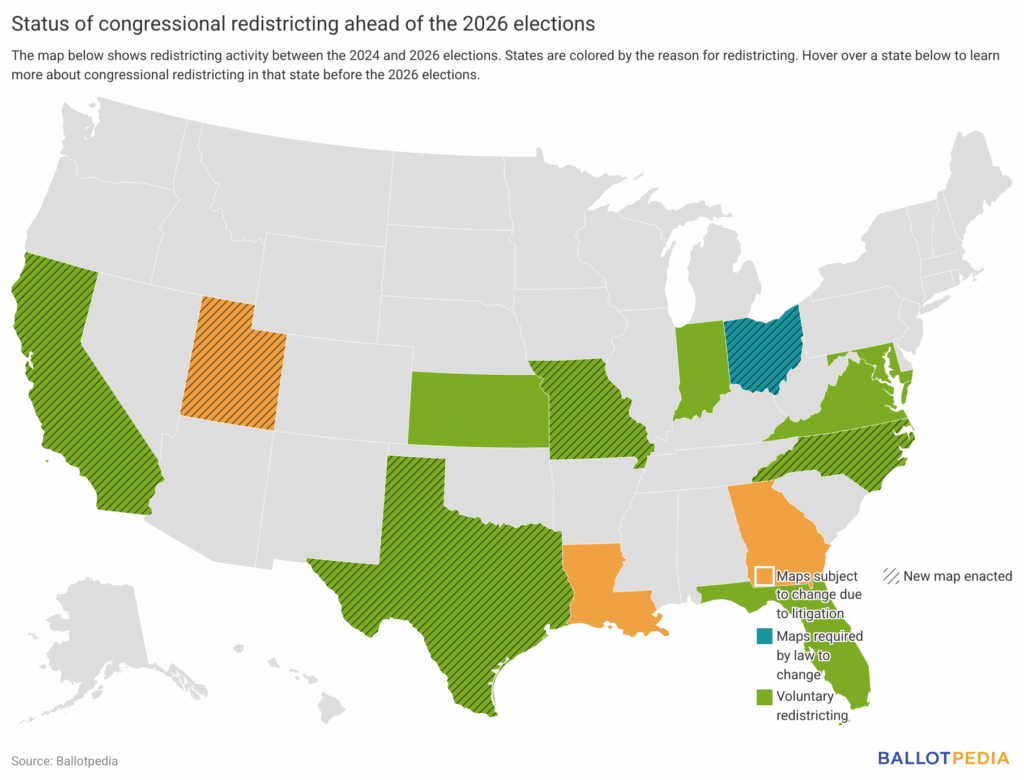Utah became the sixth state to adopt a new congressional map ahead of the 2026 census. On Nov. 10, 2025, a district court judge rejected a redrawn map submitted by the legislature that would have maintained four Republican-leaning districts in favor of a proposal from the plaintiffs in the case that shifts one district toward Democrats. According to court filings, the new Democratic-leaning Salt Lake City district is about 43% Republican.

Redistricting ahead of the 2026 elections
Five other states—four Republican-led and one Democratic-led—previously adopted new congressional maps ahead of the 2026 elections. Most recently, on Nov. 4, California voters approved Proposition 50, allowing a new map that makes five districts more favorable to Democrats according to the 2024 presidential results to take effect in the state. With the new Democratic district in Utah, that could lower the net gains from redistricting in Republican-led states from nine districts to three nationwide.
The new Texas map shifts five Democratic districts toward Republicans according to the 2024 presidential results. New maps in Missouri and North Carolina each aim to add one more Republican district. Ohio’s new map makes two Democratic-held districts more Republican, according to recent election results shared by the redistricting commission.
Three Republican-led states and two Democratic-led states are still considering redistricting before the midterm elections.

While the Florida Legislature has not yet announced a redistricting plan, on Nov. 13, Gov. Ron DeSantis (R) wrote on X, “Stay tuned…” Indiana lawmakers are expected to meet beginning on Dec. 1 to consider redrawing the state’s congressional district boundaries. According to the Indiana Capital Chronicle, seven Senate Republicans have announced their opposition to redistricting. A petition for a special session in Kansas did not generate the requisite support from Republican legislators, but the New York Times’ Mitch Smith wrote, “The debate over remapping in Kansas is not over, and new boundaries could still pass when lawmakers return for their regular session in January.”
Maryland Gov. Wes Moore (D) created a redistricting advisory commission that could propose a new congressional map ahead of the 2026 elections. Moore said, “If parts of this country are going to go through a mid-decade process to decide whether or not they have fair maps, then so will the state of Maryland.”
In October, the Virginia General Assembly approved a constitutional amendment that would allow the state to redraw its congressional lines. The amendment must pass the General Assembly again after new officeholders are sworn in before being placed on the ballot for voters to decide. Democrats gained 13 Virginia House seats in the Nov. 4 elections this year.
More on League of Women Voters v. Utah State Legislature
On March 16, 2022, the Utah League of Women Voters and Mormon Women for Ethical Government sued the Utah State Legislature, arguing the legislature violated the state constitution when it repealed and replaced the citizen-approved Proposition 4, a 2018 ballot measure that established a redistricting commission to draw congressional, state legislative, and school board district boundaries for the legislature to consider. The groups also argued the congressional map adopted in 2021 was a partisan gerrymander.
The Utah Supreme Court ruled on July 11, 2024, that the legislature's override of Proposition 4 likely violated voters' constitutional right to participate in government. The Court returned the case to Third District Court Judge Dianna Gibson to determine whether the legislature's changes to the ballot initiative were "narrowly tailored to advance a compelling government interest." On Aug. 25, 2025, Gibson struck down the state's congressional map, writing, "The nature of the violation lies in the Legislature’s refusal to respect the people’s exercise of their constitutional lawmaking power and to honor the people’s right to reform their government." On Sept. 15, 2025, the Utah Supreme Court rejected the legislature's appeal for a pause on the district court's ruling, allowing plans to redraw the map by Nov. 10, 2025, to proceed.
On Oct. 6, 2025, the legislature submitted a map and the plaintiffs submitted two maps to Gibson for consideration. On Nov. 10, Gibson chose the plaintiffs’ Map 1 to use in the 2026 elections.
Utah House Speaker Mike Schultz (R) said the legislature would seek to reverse the decision, stating, “You had a judge completely ignore the Constitution, come up with her own process and her own outcome, outside of the Constitution. This should make every Utahn scared.”
State Rep. Matt MacPherson (R) wrote on X, “I have opened a bill to file articles of impeachment against Judge Gibson for gross abuse of power, violating the separation of powers and failing to uphold her oath of office to the Utah Constitution.”
The Utah House and Senate Democrats wrote in a joint statement that they “feel a deep sense of hope and relief following Judge Gibson’s decision to adopt the plaintiffs’ Map 1. This is a win for every Utahn. We took an oath to serve the people of Utah, and fair representation is the truest measure of that promise.”


